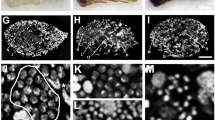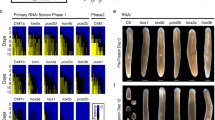Abstract
Polyembryonic development is a unique mode of metazoan development in which a single zygote generates multiple embryos by clonal proliferation1. The polyembryonic parasitic insect Copidosoma floridanum shows one of the most extreme cases of polyembryony, producing up to 2,000 embryos from a single egg. In addition, this wasp exhibits an unusual polyphenism, producing two morphologically distinct larval castes, termed precocious and reproductive, that develop clonally from the same zygote2. This form of development seems incompatible with a model of insect development in which maternal pre-patterning of the egg specifies embryonic axial polarity3. Here we show that maternal pre-patterning in the form of germ plasm creates cellular asymmetry at the four-cell stage embryo of Copidosoma that is perpetuated throughout development. Laser ablations of cells show that the cell inheriting the germ plasm regulates both the fate and proliferation of the reproductive caste. Thus, we have uncovered a new mechanism of caste specification, mediated by the regulatory capacity of a single cell. This study shows that the evolution of mammalian-like regulative development of an insect embryo relies on a novel cellular context that might ultimately enhance developmental plasticity.
This is a preview of subscription content, access via your institution
Access options
Subscribe to this journal
Receive 51 print issues and online access
$199.00 per year
only $3.90 per issue
Buy this article
- Purchase on Springer Link
- Instant access to full article PDF
Prices may be subject to local taxes which are calculated during checkout




Similar content being viewed by others
References
Craig, S. F., Slobodkin, L. B., Wray, G. A. & Biermann, C. H. The ‘paradox’ of polyembryony: A review of the cases and a hypothesis for its evolution. Evol. Ecol. 11, 127–143 (1997)
Strand, M. R. & Grbic, M. The development and evolution of polyembryonic insects. Curr. Top. Dev. Biol. 35, 121–159 (1997)
Meinhardt, H. Organizer and axes formation as a self-organizing process. Int. J. Dev. Biol. 45, 177–188 (2001)
Abouheif, E. & Wray, G. A. Evolution of the gene network underlying wing polyphenism in ants. Science 297, 249–252 (2002)
Nijhout, H. F. Control mechanisms of polyphenic development in insects. Bioscience 49, 181–192 (1999)
Schwalm, F. Insect morphogenesis (Karger, Basel, 1988)
Grbić, M., Nagy, L. M., Carroll, S. B. & Strand, M. R. Polyembryonic development: insect pattern formation in a cellularized environment. Development 121, 795–804 (1996)
Grbić, M., Nagy, L. & Strand, M. R. Development of polyembryonic insects: a major departure from typical insect embryogenesis. Dev. Genes Evol. 208, 69–81 (1998)
Cruz, Y. P. A sterile defender morph in a polyembryonic hymenopterous parasite. Nature 294, 446–447 (1981)
Grbić, M., Ode, P. J. & Strand, M. R. Sibling rivalry and brood sex-ratios in polyembryonic wasps. Nature 360, 254–256 (1992)
Grbić, M. ‘Alien’ wasps and evolution of development. BioEssays 22, 920–932 (2000)
Goldstein, B. & Freeman, G. Axis specification in animal development. BioEssays 19, 105–116 (1997)
St Johnston, D. & Nüsslein-Volhard, C. The origin of pattern and polarity in the Drosophila embryo. Cell 68, 201–219 (1992)
Saitou, M., Barton, S. C. & Surani, M. A. A molecular programme for the specification of germ cell fate in mice. Nature 418, 293–300 (2002)
Silvestri, F. Contribuzioni alla conoscenza biologica degli imenotteri parasiti. Biologia del Litomastix truncatellus (Dalm.) (2 nota preliminare). Ann. Regia Sci. Agric. Portici 6, 3–59 (1906)
Saffman, E. E. & Lasko, P. Germline development in vertebrates and invertebrates. Cell. Mol. Life Sci. 55, 1141–1163 (1999)
Evans, J. D. & Wheeler, D. E. Gene expression and the evolution of insect polyphenisms. BioEssays 23, 62–68 (2001)
Pedersen, R. A. in Experimental Approaches to Mammalian Embryonic Development (eds Rosant, J. & Pedersen, R. A.) 3–33 (Cambridge Univ. Press, Cambridge, 1986)
Underwood, E. M., Caulton, J. H., Allis, C. D. & Mahovald, A. P. Developmental fate of pole cells in Drosophila melanogaster. Dev. Biol. 77, 303–314 (1980)
Geberding, M., Browne, W. E. & Patel, N. H. Cell lineage analysis of amphipod crustacean Parhyale hawaiensis reveals an early restriction of cell fate. Development 129, 5789–5801 (2002)
Johnson, A. D. et al. Regulative germ cell specification in axolotl embryos: a primitive trait conserved in the mammalian lineage. Phil. Trans. R. Soc. Lond. B 358, 1371–1379 (2003)
Piotrowska, K. & Zernicka-Goetz, M. Role for sperm in spatial patterning of the early mouse embryo. Nature 409, 517–521 (2001)
Gardner, R. L. Specification of embryonic axis begins before cleavage in normal mouse development. Development 128, 839–847 (2001)
Thompson, J. D., Higgins, D. G. & Gibson, T. J. CLUSTAL W: improving the sensitivity of progressive multiple sequence alignment through sequence weighting, position-specific gap penalties and weight matrix choice. Nucleic Acids Res. 22, 4673–4680 (1994)
Strimmer, K. & von Haeseler, A. Likelihood-mapping: a simple method to visualize phylogenetic content of a sequence alignment. Proc. Natl Acad. Sci. USA 94, 6815–6819 (1997)
Dearden, P. K. & Akam, M. Early embryo patterning in grasshopper, Shistocerca gregaria: wingless, decapentaplegic and caudal expression. Development 128, 3435–3444 (2001)
Lasko, P. F. & Ashburner, M. Posterior localisation of Vasa protein correlates with, but is not sufficient for, pole cell development. Genes Dev. 4, 905–921 (1990)
Woodring, J., Das, S. & Gade, G. Hypertrehalosemic factors from the corpora cardiaca of the honeybee (Apis melifera) and the paper wasp (Polistes exclamans). J. Insect Physiol. 40, 685–692 (1994)
Baehrecke, E. H., Aiken, J. M., Dover, B. A. & Strand, M. R. Ecdysteroid induction of embryonic morphogenesis in a parasitic wasp. Dev. Biol. 158, 275–287 (1993)
Grbić, M., Rivers, D. & Strand, M. R. Caste formation in the polyembryonic wasp Copidosoma floridanum (Hymenoptera: Encyrtidae): In vivo and in vitro analysis. J. Insect Physiol. 43, 553–565 (1997)
Acknowledgements
We are thankful to L. Nagy for the idea of performing embryo transplantation into host eggs; E. Zhurov for expert embryo transplantation; P. Lasko, L. Nagy, L. Dickinson, T. Reavell, T. Drysdale, P. Wigge and G. Velicer for critical reading of the manuscript; E. Zhurov and I. Craig for the artwork; J. Whistlecraft, L. Verdon and N. Terzin for Copidosoma rearing; and R. Kulperger for the statistical analysis. M.G. thanks V. Grbić and Ž. Srdić for introducing him to parasitic wasps. This work was supported by grants from the Canadian Foundation of Innovation, Premier's Research Excellence Award and National Science and Engineering Research Council to M.G.
Author information
Authors and Affiliations
Corresponding author
Ethics declarations
Competing interests
The authors declare that they have no competing financial interests.
Supplementary information
Copidosoma embryo movements: in vitro embryo culture
Time-lapse of early Copidosoma primary morula movement in in vitro embryo culture. Digital image capture was performed every 1 minute over 2 hours. (MOV 1331 kb)
Multiple sequence alignment of Vasa proteins
Multiple sequence alignment of Vasa proteins used for phylogenetic analysis of Copidosoma Vasa amino acid sequence in CLUSTAL W format. Below the compared sequences, identical amino acids are denoted by an asterisk (*), conserved amino acids are denoted by a colon (:), and semi-conserved amino acids by a period (.). Alignment was manually edited. (PDF 10 kb)
Rights and permissions
About this article
Cite this article
Zhurov, V., Terzin, T. & Grbić, M. Early blastomere determines embryo proliferation and caste fate in a polyembryonic wasp. Nature 432, 764–769 (2004). https://doi.org/10.1038/nature03171
Received:
Accepted:
Issue Date:
DOI: https://doi.org/10.1038/nature03171
This article is cited by
-
Environmental and genetic controls of soldier caste in a parasitic social wasp
Scientific Reports (2012)
-
The polyembryonic wasp Copidosoma floridanum produces two castes by differentially parceling the germ line to daughter embryos during embryo proliferation
Development Genes and Evolution (2009)
-
Germ cell development in the Honeybee (Apis mellifera); Vasa and Nanosexpression
BMC Developmental Biology (2006)
-
vasa mRNA accumulates at the posterior pole during blastoderm formation in the flour beetle Tribolium castaneum
Development Genes and Evolution (2006)
-
Compatible invasion of a phylogenetically distant host embryo by a hymenopteran parasitoid embryo
Cell and Tissue Research (2006)
Comments
By submitting a comment you agree to abide by our Terms and Community Guidelines. If you find something abusive or that does not comply with our terms or guidelines please flag it as inappropriate.



